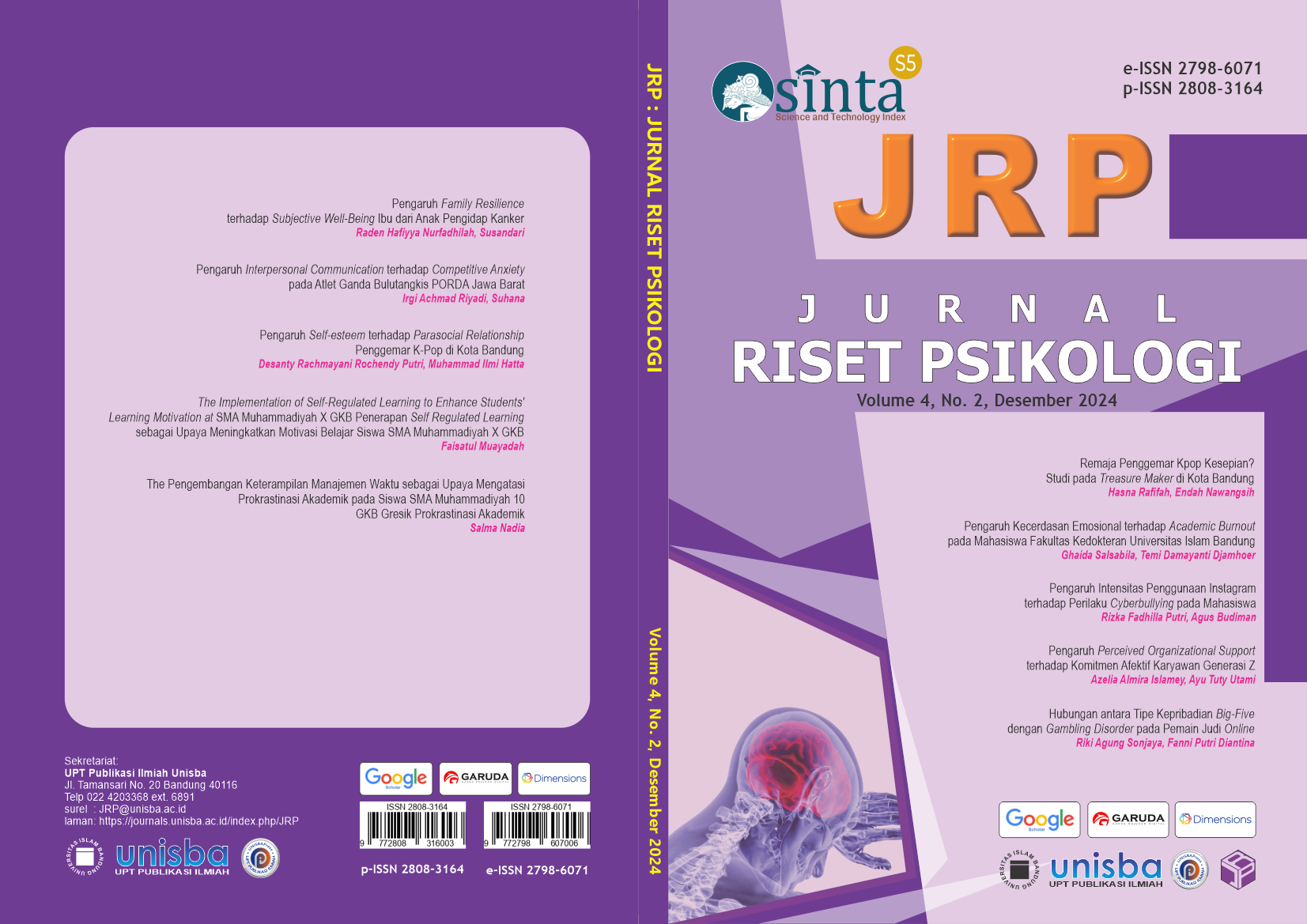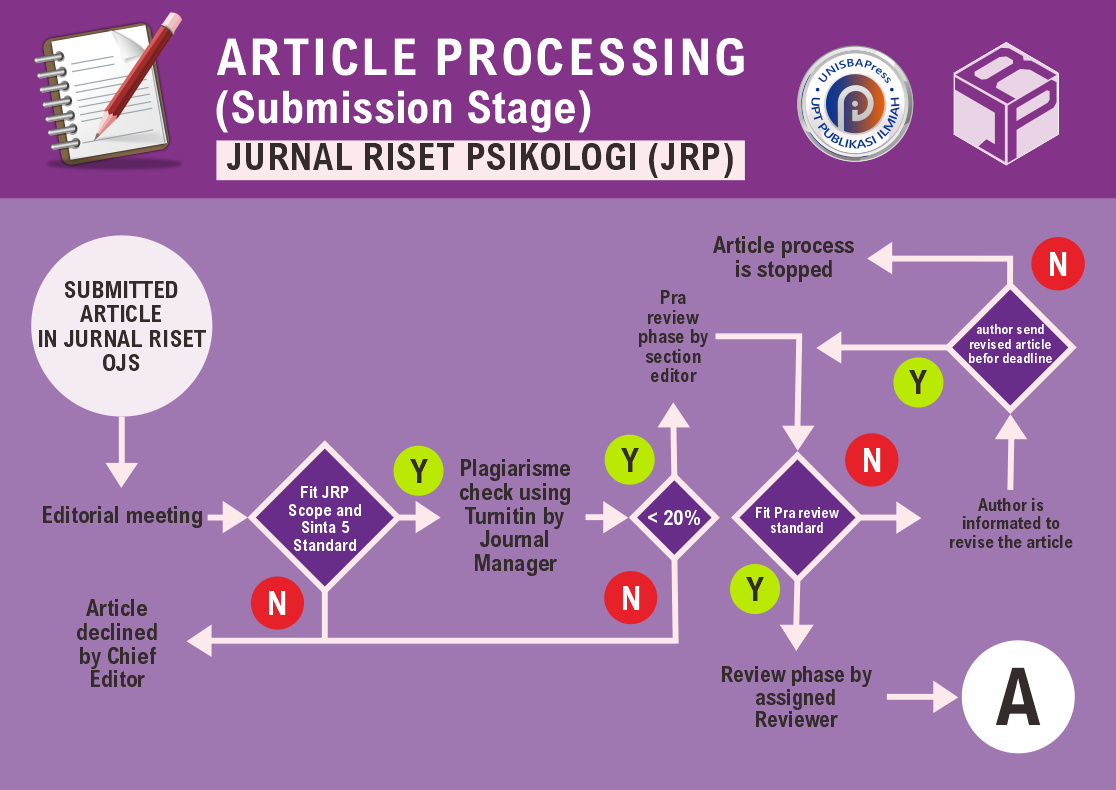Pengaruh Interpersonal Communication terhadap Competitive Anxiety pada Atlet Ganda Bulutangkis PORDA Jawa Barat
DOI:
https://doi.org/10.29313/jrp.v4i2.5273Keywords:
Atlet Ganda Bulutangkis, Kecemasan Bertanding, Komunikasi InterpersonalAbstract
Abstract. Psychological factors play a crucial role in sport, as they drive or direct athlete performance and determine 80% of athlete victories. One of the psychological factors that affect athletes during competition is anxiety. One response that can affect athlete anxiety is interpersonal communication. This study uses a quantitative research design with the causality method. The research sample consisted of 133 respondents of West Java PORDA badminton doubles athletes with random sampling technique. The measuring instruments used were the Interpersonal Communication Inventory from Millard J. Bienvenu and the Sport Competition Anxiety Test from Rainer Martens. Data analysis was performed using simple linear regression techniques to measure the effect of Interpersonal Communication and Competitive Anxiety. The results showed that Interpersonal Communication had an influence of 20.6% on Competitive Anxiety in West Java PORDA badminton doubles athletes with an R Square value of 0.103. These findings indicate that the effect of Interpersonal Communication on Competitive Anxiety is in the low category. This shows that there are 79.4% other factors that influence Competitive Anxiety. Future research needs to consider other independent variables that can affect Competitive Anxiety and reconsider the sample criteria to be used.
Abstrak. Faktor psikologis memiliki peran krusial dalam olahraga, karena menjadi pendorong atau pengarah performa atlet dan menentukan 80% dari kemenangan atlet. Salah satu faktor psikologis yang mempengaruhi atlet saat kompetisi adalah kecemasan. Salah satu respons yang dapat mempengaruhi kecemasan atlet adalah komunikasi interpersonal. Penelitian ini menggunakan desain penelitian kuantitatif dengan metode kausalitas. Sampel penelitian terdiri dari 133 responden atlet ganda bulutangkis PORDA Jawa Barat dengan teknik random sampling. Alat ukur yang digunakan adalah Interpersonal Communication Inventory dari Millard J. Bienvenu dan Sport Competition Anxiety Test dari Rainer Martens. Analisis data dilakukan menggunakan teknik regresi linear sederhana untuk mengukur pengaruh Interpersonal Communication dan Competitive Anxiety. Hasil penelitian menunjukkan bahwa Interpersonal Communication memiliki pengaruh sebesar 20,6% terhadap Competitive Anxiety pada atlet ganda bulutangkis PORDA Jawa Barat dengan nilai R-Square sebesar 0,103. Temuan ini menunjukkan bahwa pengaruh Interpersonal Communication terhadap Competitive Anxiety berada pada kategori rendah. Hal ini menunjukkan bahwa terdapat 79,4% faktor lainnya yang mempengaruhi Competitive Anxiety. Penelitian selanjutnya perlu mempertimbangkan variabel independen lain yang dapat mempengaruhi Competitive Anxiety dan mempertimbangkan kembali kriteria sampel yang akan digunakan.
References
W. Adisasmito, “Sistem Kesehatan Nasional,” 2007.
S. Gunarsa, Psikologi perkembangan anak dan remaja. BPK Gunung Mulia, 2008.
E. R. Aly, “COMMUNICATION MANAGEMENT AMONG ATHLETE AND COACHES,” Eur Sci J, vol. 3, 2014.
M. P. Satiadarma, Dasar-dasar psikologi olahraga. Jakarta: Pustaka Sinar Harapan, 2000.
I. F. SHOLICHAH and M. Jannah, “Pengaruh Pelatihan Quiet Eye Training Terhadap Peningkatan Konsentrasi Pada Atlet Bulutangkis,” Character : Jurnal Penelitian Psikologi, vol. 3, no. 3, 2015.
E. N. Rachmaningdiah and M. Jannah, “Pengaruh Pelatihan Otogenik Terhadap Penurunan Kecemasan Atlet Bulutangkis,” Jurnal Psikologi Teori dan Terapan, vol. 6, no. 2, p. 107, Feb. 2016, doi: 10.26740/jptt.v6n2.p107-112.
Z. Arifin and H. Wahyudi, “RAGAM MOTIVASI ATLET DALAM BERPRESTASI OLAHRAGA,” Jurnal Kesehatan Olahraga, vol. 9, no. 2, 2021.
S. A. Beebe, S. J. Beebe, and M. V. Redmond, Interpersonal communication: relating to others, vol. 5. USA: Allynand Bacon, 1999.
K. Floyd, Interpersonal communication , vol. 2. New York: McGraw-Hill, 2011.
M. Faturochman, “PENGARUH KECEMASAN BERTANDING TERHADAP PEAK PERFORMANCE PADA ATLET SOFTBALL UNIVERSITAS NEGERI YOGYAKARTA,” Jurnal Riset Mahasiswa Bimbingan dan Konseling, vol. 3, no. 1, 2016.
Martini, “Perang Dingin Paling Heboh di Dunia Bulutangkis, Pramudya/Yeremia Masih Panas,” Indosport. [Online]. Available: https://www.indosport.com/raket/20231015/3-perang-dingin-paling-heboh-di-bulutangkis-pramudya-yeremia-masih-panas?page=2
V. L. Huber, “Effects of task difficulty, goal setting, and strategy on performance of a heuristic task.,” Journal of Applied Psychology, vol. 70, no. 3, pp. 492–504, Aug. 1985, doi: 10.1037/0021-9010.70.3.492.
G. P. Latham and L. M. Saari, “Importance of supportive relationships in goal setting.,” Journal of Applied Psychology, vol. 64, no. 2, pp. 151–156, Apr. 1979, doi: 10.1037/0021-9010.64.2.151.
O. Setiani and H. Sakti, “HUBUNGAN ANTARA EFEKTIVITAS KOMUNIKASI INTERPERSONAL PELATIH DAN ATLETDENGAN KECEMASAN BERTANDING PADA ATLET PERSATUAN BULUTANGKIS SELURUH INDONESIA SEMARANG,” Jurnal EMPATI, vol. 3, no. 3, pp. 186–195, 2014.
J. I. Sabilla and M. Jannah, “Intimasi Pelatih-Atlet dan Kecemasan Bertanding Pada Atlet Bola Voli Putri,” Jurnal Psikologi Teori dan Terapan, vol. 7, no. 2, p. 123, Mar. 2017, doi: 10.26740/jptt.v7n2.p123-129.
A. Wasan, “Komunikasi interpersonal pelatih dan atlet klub petanque Universitas Negeri Jakarta,” Jakarta: In Prosiding Seminar dan Lokakarya Fakultas Ilmu Keolahragaan Universitas Negeri Jakarta, pp. 50–57.
S. D. Mellalieu, S. Hanton, and D. Fletcher, A competitive anxiety Review: Recent direction in Sport Psychology research. New York: Nova Science Publishers, 2009.
R. Martens, R. S. Vealy, and D. Burton, Competitive anxiety sport. Illinois: Human Kinetics, 1990.
J. A. Devito, Komunikasi Antarmanusia. Tangerang Selatan: KARISMA Publishing Group, 2011.
A. M. Hardjana, Komunikasi intrapersonal & Komunikasi Interpersonal. Yogyakarta: Penerbit Kanisius, 2003.













